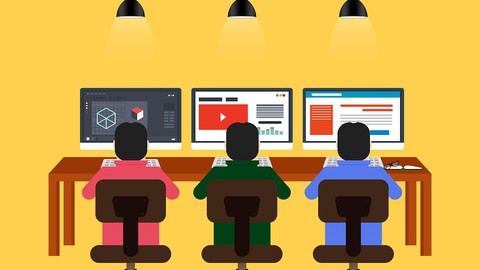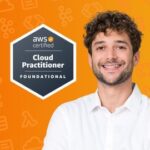
VB . NET with VS 2017 and Windows Forms
VB . NET with VS 2017 and Windows Forms, available at $69.99, has an average rating of 4.39, with 86 lectures, based on 896 reviews, and has 5222 subscribers.
You will learn about Learn how to work with events Learn Basic Graphical Interface Design Learn Visual Basic . NET Learn How to Build DLL's Learn how to control program flow Learn about the .NET Framework source code Learn how to build a text editor with saving, opening and printing and other functions Learn how C# powers the .NET Framework and how VB relates Learn the practical benefits of polymorphism Learn how to use the memory window Learn how to use a variety of looping structures in a practical context Please read the course curriculum to see everything the course has to offer This course is ideal for individuals who are Those who are interested in Objected Oriented Programming or Those who are interested in Windows Forms or Do not take this course if you want to study Visual Basic using console programs or Do not take this course if you do not enjoy detailed explanations or Do not take this course if you do not enjoy videos that are 13 minutes on average It is particularly useful for Those who are interested in Objected Oriented Programming or Those who are interested in Windows Forms or Do not take this course if you want to study Visual Basic using console programs or Do not take this course if you do not enjoy detailed explanations or Do not take this course if you do not enjoy videos that are 13 minutes on average.
Enroll now: VB . NET with VS 2017 and Windows Forms
Summary
Title: VB . NET with VS 2017 and Windows Forms
Price: $69.99
Average Rating: 4.39
Number of Lectures: 86
Number of Published Lectures: 86
Number of Curriculum Items: 86
Number of Published Curriculum Objects: 86
Original Price: $89.99
Quality Status: approved
Status: Live
What You Will Learn
- Learn how to work with events
- Learn Basic Graphical Interface Design
- Learn Visual Basic . NET
- Learn How to Build DLL's
- Learn how to control program flow
- Learn about the .NET Framework source code
- Learn how to build a text editor with saving, opening and printing and other functions
- Learn how C# powers the .NET Framework and how VB relates
- Learn the practical benefits of polymorphism
- Learn how to use the memory window
- Learn how to use a variety of looping structures in a practical context
- Please read the course curriculum to see everything the course has to offer
Who Should Attend
- Those who are interested in Objected Oriented Programming
- Those who are interested in Windows Forms
- Do not take this course if you want to study Visual Basic using console programs
- Do not take this course if you do not enjoy detailed explanations
- Do not take this course if you do not enjoy videos that are 13 minutes on average
Target Audiences
- Those who are interested in Objected Oriented Programming
- Those who are interested in Windows Forms
- Do not take this course if you want to study Visual Basic using console programs
- Do not take this course if you do not enjoy detailed explanations
- Do not take this course if you do not enjoy videos that are 13 minutes on average
Most Important Thing: Please take the time to watch the free preview videos, so you can be sure my style of presentation, the pace of presentation, and the overall feel of the course are truly what you are looking for.
Who should join:
0. This is a course for those who are willing to push themselves. It’s not a “basic” introduction that gives an overly simplified perspective on VB. In places, this code connects to the .NET framework, which is a professional level code base written in C#. My promise is simple: take this course, and you’ll discover details not taught in any other course. Speaking from experience, I can tell you that it is through consistent, daily effort, and I don’t mean little effort, but wholehearted effort, that one makes progress when it comes to these technical subjects. That’s what years of struggling have taught me.
1. This course uses the latest preview version of Visual Studio 2017
2. This course jumps into aspects of object-oriented programming early, so you can see real VB as soon as possible.
a. This does not mean that every aspect of OOP is covered immediately
b. It just mentions enough OOP to see what’s needed to make reasonable progress
3. This course provides detailed explanations, so please be sure you enjoy fine detail before enrolling
4. If you are looking for fast, superficial explanations, and five minutes videos, this course will NOT help you
5. There are videos on what happens in your computer memory and how the .NET Framework and C# connect to VB . NET
6. When I delve into the .NET Framework source code, you will also see C# in operation, and therefore the code will be complex.
7. Clear, crisp audio done with a studio microphone
8. Review questions are now embedded directly into the videos at different points, and there are many of them in the videos
9. You will not see videos on things like printing 1,2,3,4,5 using a loop because this has little practical value
10. You will see more practical videos on things like using loops to read files/write files
11. The videos are straightforward code examples, with no talking head or distracting graphics
12. Some of my explanations step through the code line by line using the debugger, so if you are impatient, this likely will not work for you
13. There is a text editor project on the bottom
14. You also learn about the practical implications of polymorphism and interfaces
15. I also show you how to use a variety of features in Visual Studio 2017
16. You can adjust the playback speed on the player very easily to 0.5, 0.75, 1.25,1.5 and 2 times the regular speed so you can learn at a pace that truly works for you
Who Should Not Join:
1. People who want to learn VB . NET through console programs
2. Those who are not ready to be exposed to object-oriented programming
3. People who want five-minute videos would not be the right fit for this course
4. People who do not enjoy detailed explanations would not be the right fit for this course
5. People who do not want to answer review questions would not be the right fit for this course
6. People who are not willing to do whatever it takes to push their skills higher
Course Curriculum
Chapter 1: Programming Basics with OOP
Lecture 1: Get Visual Studio 2017 Community
Lecture 2: Create and Run First Windows Form Program
Lecture 3: Dig into Solutions and Projects
Lecture 4: Understand a Basic Namespace and Class
Lecture 5: Build a Form with a Button, Part 1
Lecture 6: Add a Click Event Code Handler, Part 2
Lecture 7: Add MessageBox.Show to Event Handler, Part 3
Lecture 8: Use One Variable with TrackBar Control, Part 1
Lecture 9: Explore the Label Class with TrackBar, Part 2
Lecture 10: Use Function Chaining
Lecture 11: Build Simple Calculator Interface, Part 1
Lecture 12: Simple Calculator Code, Part 2
Lecture 13: Break from Programming: Configure VS and Install Simple Calculator App.
Lecture 14: Build Picture Viewer Interface, Part 1
Lecture 15: Dive into the .NET FrameWork and Add Code, Part 2
Lecture 16: Improve Picture Viewer with an Enumeration, Part 3
Lecture 17: Dig Deeper with the Memory Window
Lecture 18: Attaching Event Handlers to Events through Delegates
Chapter 2: OOP and Controlling Program Flow
Lecture 1: Build Interface with Check Box and Calendar Control, Part 1
Lecture 2: Add Code to Power Check Box, Part 2
Lecture 3: Break from Programming: Understand the Class Designer File
Lecture 4: Break from Programming: Understand the New Keyword More
Lecture 5: Using If With Functions and Enumerations, Part 1(Interface)
Lecture 6: Using If With Functions and Enumerations, Part 2 (Code)
Lecture 7: Using Compound Operators
Lecture 8: Looping with While Loops, Part 1
Lecture 9: Looping with While Loops, Part 2
Lecture 10: Looping with While Loops, Part 3
Lecture 11: Digging into the Stream Object at Run Time, Part 4
Lecture 12: Looping with Do Until/Loop
Lecture 13: Looping with For Each Loops, Part 1 Interface
Lecture 14: Looping with For Each Loops, Part 2 Code
Lecture 15: Digging into Indexes of a Collection, Code Part 3
Lecture 16: Looping with For Loops, Part 1(Interface)
Lecture 17: Looping with For Loops, Part 2(Code)
Lecture 18: If/Else with Menus and Form Load, Part 1
Lecture 19: If/Else with Menus and Form Load, Part 2
Lecture 20: If With Image Lists, Part 1
Lecture 21: If With Images Lists, Part 2
Lecture 22: Graphics Program, Part 1
Lecture 23: Graphics Program, Part 2
Lecture 24: Graphics Program, Part 3
Lecture 25: AndAlso Operator, Part 1
Lecture 26: And Also Operator, Part 2
Lecture 27: OrElse Operator, Part 1
Lecture 28: OrElse Operator, Part 2
Lecture 29: Using Try/Catch, Part 1
Lecture 30: Using Try/Catch, Part 2
Chapter 3: Build a Calculator
Lecture 1: Calculator Overview, Part 1
Lecture 2: Add DLL with Calculator Class, Part 2
Lecture 3: Build Calculator Interface, Part 3
Lecture 4: Update DLL to Disable Making Math Class Objects, Part 4
Lecture 5: Add Math Operation Calls, Part 5
Lecture 6: Add Button Click Handler, Part 6
Lecture 7: Add Highlighting, Part 7
Lecture 8: Digging into the .Net Framework, Part 8
Chapter 4: OOP Structures in More Detail
Lecture 1: Class Hierarchies, Part 1
Lecture 2: Class Hierarchies, Part 2
Lecture 3: Properties and Fields, Part 1
Lecture 4: Properties and Fields, Part 2
Lecture 5: Overriding Functions
Lecture 6: Properties That Can Crash and Default Values
Lecture 7: Overrides/Overridable Properties
Lecture 8: Readonly and Shared Properties
Lecture 9: Using MDI Properties, Part 1
Lecture 10: Using MDI Properties, Part 2
Lecture 11: Understand the Controls Property of the Form Object
Lecture 12: Form Class Hierarchy
Chapter 5: Text Editor App.
Lecture 1: Text Editor Overview, Step 1
Lecture 2: Build Interface, Step 2
Lecture 3: Add Opening Files, Step 3
Lecture 4: DIg into the IDisposable Interface, Step 4
Lecture 5: Add Ability to Save Files, Step 5
Lecture 6: Add Ability to Change Font Color and Style and Size, Step 6
Lecture 7: Add Ability to Print Files, Part 7
Lecture 8: Add Ability to Print Preview, Part 8
Lecture 9: Digging into Dispose Again, Part 9
Lecture 10: Add Ability to Save RTF Files
Chapter 6: Polymorphism and Interfaces
Lecture 1: Polymorphic Subs with Class Data Types, Part 1
Lecture 2: Serializing Objects, Part 1
Lecture 3: Serializing objects, Part2
Lecture 4: Serializing Objects, Part 3
Lecture 5: Inheritance through Object Declarations
Lecture 6: Abstract /MustInherit Classes Vs. Interfaces
Lecture 7: Using ByRef Functions
Chapter 7: Thanks for Watching!
Lecture 1: Thanks for Visiting!
Instructors
-
T O
Spreader of Knowledge
Rating Distribution
- 1 stars: 9 votes
- 2 stars: 12 votes
- 3 stars: 112 votes
- 4 stars: 342 votes
- 5 stars: 421 votes
Frequently Asked Questions
How long do I have access to the course materials?
You can view and review the lecture materials indefinitely, like an on-demand channel.
Can I take my courses with me wherever I go?
Definitely! If you have an internet connection, courses on Udemy are available on any device at any time. If you don’t have an internet connection, some instructors also let their students download course lectures. That’s up to the instructor though, so make sure you get on their good side!
You may also like
- Best Public Speaking Courses to Learn in March 2025
- Best Affiliate Marketing Courses to Learn in March 2025
- Best Email Marketing Courses to Learn in March 2025
- Best Social Media Management Courses to Learn in March 2025
- Best SEO Optimization Courses to Learn in March 2025
- Best Content Creation Courses to Learn in March 2025
- Best Game Development Courses to Learn in March 2025
- Best Software Testing Courses to Learn in March 2025
- Best Big Data Courses to Learn in March 2025
- Best Internet Of Things Courses to Learn in March 2025
- Best Quantum Computing Courses to Learn in March 2025
- Best Cloud Computing Courses to Learn in March 2025
- Best 3d Modeling Courses to Learn in March 2025
- Best Mobile App Development Courses to Learn in March 2025
- Best Graphic Design Courses to Learn in March 2025
- Best Videography Courses to Learn in March 2025
- Best Photography Courses to Learn in March 2025
- Best Language Learning Courses to Learn in March 2025
- Best Product Management Courses to Learn in March 2025
- Best Investing Courses to Learn in March 2025






















